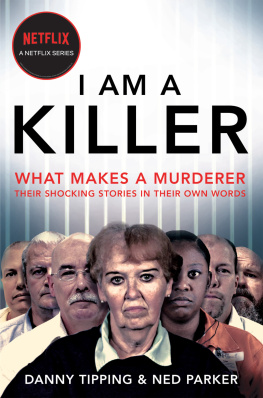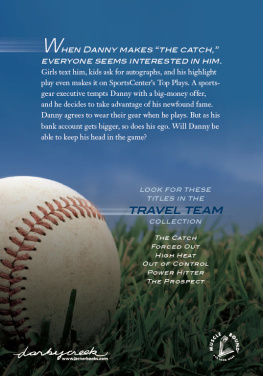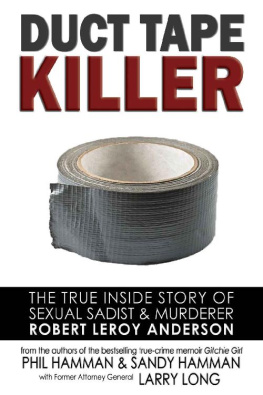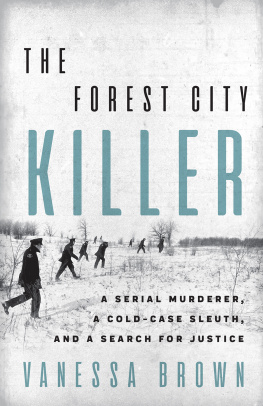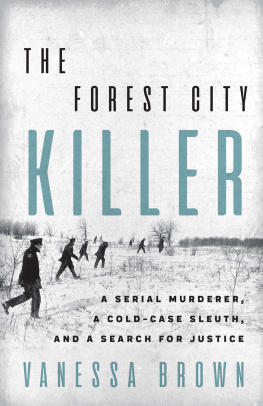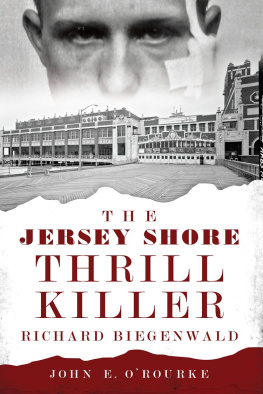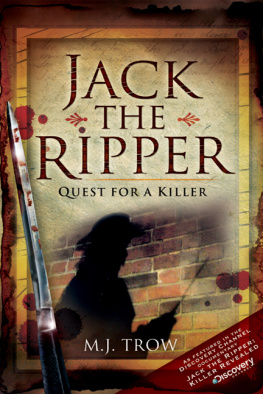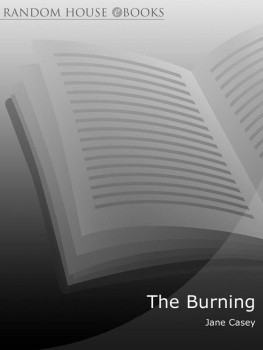Danny Tipping - I Am a Killer: What Makes a Murderer
Here you can read online Danny Tipping - I Am a Killer: What Makes a Murderer full text of the book (entire story) in english for free. Download pdf and epub, get meaning, cover and reviews about this ebook. year: 2022, publisher: Pan Macmillan UK, genre: Detective and thriller. Description of the work, (preface) as well as reviews are available. Best literature library LitArk.com created for fans of good reading and offers a wide selection of genres:
Romance novel
Science fiction
Adventure
Detective
Science
History
Home and family
Prose
Art
Politics
Computer
Non-fiction
Religion
Business
Children
Humor
Choose a favorite category and find really read worthwhile books. Enjoy immersion in the world of imagination, feel the emotions of the characters or learn something new for yourself, make an fascinating discovery.
- Book:I Am a Killer: What Makes a Murderer
- Author:
- Publisher:Pan Macmillan UK
- Genre:
- Year:2022
- Rating:3 / 5
- Favourites:Add to favourites
- Your mark:
- 60
- 1
- 2
- 3
- 4
- 5
I Am a Killer: What Makes a Murderer: summary, description and annotation
We offer to read an annotation, description, summary or preface (depends on what the author of the book "I Am a Killer: What Makes a Murderer" wrote himself). If you haven't found the necessary information about the book — write in the comments, we will try to find it.
I Am a Killer: What Makes a Murderer — read online for free the complete book (whole text) full work
Below is the text of the book, divided by pages. System saving the place of the last page read, allows you to conveniently read the book "I Am a Killer: What Makes a Murderer" online for free, without having to search again every time where you left off. Put a bookmark, and you can go to the page where you finished reading at any time.
Font size:
Interval:
Bookmark:


When we made the I Am A Killer films, we knew we had more fascinating material than we could include in each episode. We had to be selective, and this meant a raft of interesting interviews, details and background to the killers and their victims had to be left out.
Thats why we decided to write this book, choosing ten of the most compelling stories featured in the first two series.
Here we can give an even fuller picture, including more of the research that went into choosing the killers. The book also gives us the opportunity to explain the protocols we set up for making I Am A Killer.
From the moment we first talked about making I Am A Killer we knew we did not want to make another typical true crime drama series. At our initial discussion we felt strongly that it had to be different. Most true crime films have a formula: the investigator, a couple of journalists who followed the case, a reconstruction of the crime, a forensic psychologist or criminologist who has no direct connection with the case but can talk generically about the killer.
We realized that the one person who could tell us what really happened, and usually the last person to see the victim alive, is the killer, and we wanted to talk to them. That raised the bar: we needed a face-to-face interview with the killer, not a letter, not a phone call. Was that even possible?
We hoped that by these interviews we could learn more about the causes and consequences of violent crime, and this has always been our main aim.
We ruled out interviewing serial killers, anyone involved in sexual crimes, paedophilia, or mass shootings. We did not want to feature anything that might encourage copycat behaviour. We wanted viewers to see the individuals we featured as human beings, but that doesnt necessarily mean they are going to like them.
Finding the right cases was a massive undertaking. America was the natural place to concentrate on. In the USA the average time from conviction to execution is about seventeen years. This gives the opportunity to talk to the killers, and it also means they have had time to contemplate their crimes, perhaps to work out exactly what was happening at that one moment that has defined their lives. Its also a country where the death penalty is still prevalent, with about 2,800 people on Death Row. The murder rates in the States are high (5.8 per 100,000 population, compared to 1.2 in the UK), and the incarceration rates are far higher, with much longer sentences, than in any other civilized country.
Crucially, in the US there is a very strong tradition of free speech and press access, so our film crews were able to get inside the prisons to carry out the interviews.
We started writing to prisoners and the prison services, and we received a flood of replies, several thousand. Many of them were insisting they did not do the crime, so straight away we were not interested in them. We didnt want: I wasnt there, I didnt do it. We werent looking for campaigns to have justice overturned. We had to find people who admitted their guilt, took responsibility for what happened.
In order to shortlist the ones we really wanted to feature, several criteria were laid down. All the men and women featured in the series either pleaded guilty or have been found guilty at their trials, and they accept their guilt. They are either on Death Row, waiting for their lives to be legally ended, or they are serving very long sentences that will, for most of them, mean they will never see life outside the prison walls.
An admission of guilt entirely removes the whodunnit element. It takes the film away from being purely entertainment. We are asking: Who is this person? Why did this happen? Because we are not trying to prove anything, it becomes a lot more compelling.
The films are not only about the murderers version of what happened. Every story is looked at through their eyes, but also from the perspective of others involved in the case: the anguish of the victims families, the insights of the police, the lawyers and the jurors, the pain of those who care about the prisoner. They, the murderers, also have to confront what others are saying about them, often with surprising results.
The films and this book leave it up to you, the viewer, to make up your own mind about the killers. We do not know for certain to what degree they, or anyone else we speak to, is telling the truth. Where there is an obvious untruth we make it clear, and where there are conflicting versions of events we are careful to illustrate it. Otherwise we allow everybody the opportunity to say their piece, and we leave it to the viewer or reader to decide what to believe.
There is no agenda from us as film makers: we are not campaigning; we are not inviting you to share an opinion. Instead, our aim is to lay out the case in front of you, and then its over to you.
Most of the cases have never been featured on film before. The killers are not well-known names. But every one of them has a compelling story to tell.
Another of the key criteria was: why would we tell this story at all? Whats the point? We felt we wanted to shine a light on bigger issues, and all of the stories we selected have a larger purpose. For example, the effect of childhood sexual abuse; racial and gender discrimination; an examination of the law. We never wanted our coverage to be mawkish curiosity. We arent really interested in the crime itself; we only feature it to make sense of the story, we dont sensationalize it or show anything vicarious.
The stories may have a binary outcome in terms of innocent or guilty, death sentence or life in prison without parole. But that massively oversimplifies whats happened. There are other dimensions and complications, and thats what we wanted to show.
Were introducing the topic, asking the questions. We feel making documentaries is as much about the questions you ask as the ones you answer. Do we believe they are telling the truth? Do we believe the circumstances the killers found themselves in can be mitigated? Do we believe they have been treated fairly by the law? Quite deliberately we dont answer these questions (although we have discussed them endlessly). We want the audience to make up their own minds, because we hope to encourage debate about the issues.
We decided the films would not have a narrated voice-over, prompting the viewers to follow the story in a particular way. It was a huge challenge for us because the voice-over is normally the Get Out of Jail card. If something needs signposting, you just write a line of commentary. But in keeping with the whole ethos, we couldnt do that. It meant we had to tell the entire story from the interviews.
For the first series we narrowed it down to twenty to thirty strong cases, further whittled down to fourteen, all suitable as far as we could see from contact with the prisoners. Having chosen our list, we negotiated with the prison authorities, a long process. Then our researchers set out to find other people who could be interviewed about the prisoners story.
It took over a year to finalize all the plans for shooting those ten films. Only when everything was in place did we contact the victims families. We felt there was no sense in approaching them earlier because we did not want to worry them about something that might never happen. But if we cant get their participation, sometimes the story has to be abandoned. Even with everything else in place, unless we can get someone to speak for the other side of the equation, it doesnt qualify as an
Font size:
Interval:
Bookmark:
Similar books «I Am a Killer: What Makes a Murderer»
Look at similar books to I Am a Killer: What Makes a Murderer. We have selected literature similar in name and meaning in the hope of providing readers with more options to find new, interesting, not yet read works.
Discussion, reviews of the book I Am a Killer: What Makes a Murderer and just readers' own opinions. Leave your comments, write what you think about the work, its meaning or the main characters. Specify what exactly you liked and what you didn't like, and why you think so.

